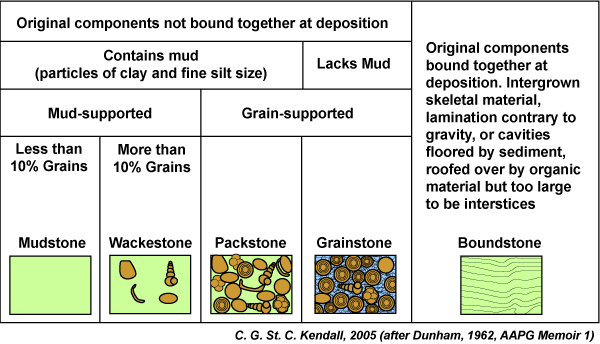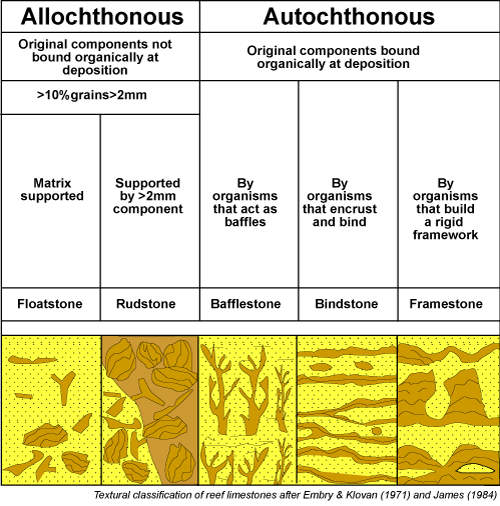Rocks are classified in order to communicate information about them. All classifications of limestones are arbitrary and they frequently overlap or do not fit ones particular needs. Since binocular microscopes or hand lenses are the tools that are commonly available to the explorationist, a practical classification should be based on descriptions using them. When these instruments are used, it is usually possible to identify the individual grains forming the Rock. Thus most classifications require that the most significant sedimentary particle in the Rock be described. For instance, if a Rock is composed of ooids, it is termed and oolitic limestone. If the limestone also contains a minor element such as skeletal fragments, then it is called a skeletal-oolitic limestone.
Two of the most widely used classifications are those of Folk (1959,1962) and Dunham (1962). Both classifications subdivide limestones primarily on the basis of matrix content.

Most limestones are classified by Folk allochemical Rocks if they contain over l0% allochems (transported carbonate grains). Based on the percentage of interstitial material, the Rocks may be further subdivided into two groups: sparry allochemical limestones (containing a sparry calcite cement of clear coarsely crystalline mosaic calcite crystals) and microcrystalline allochemical limestone(containing microcrystalline calcite mud, micrite, which is subtranslucent grayish or brownish particles less than about 5 microns in size). Further subdivision is based on the allochem ratios of Folk (1962) are shown in Scholle & Ulmer-Scholle (2003).
Thus Folk's classification (figures above) is most suited for thin section study. Remember that he terms Rocks with appreciable matrix as micrites while matrix-free Rocks that contain sparry calcite cement are termed sparites. As you can see sparites and micrites are further subdivided by means of their most common grains.


In contrast, Dunham's classification (figures above) and its modification by Embry and Klovan (1971) and James (1984) deals with depositional texture. For this reason, his scheme may be better suited for Rock descriptions that employ a hand lens or binocular microscope. For example, if the grains of a limestone are touching one another and the sediment contains no mud, then the sediment is called a grainstone. If the carbonate is grain supported but contains a small percentage of mud, then it is known as a packstone. If the sediment is mud supported but contains more than 10 percent grains, then it is known as a wackestone, and if it contains less than 10 percent grains and is mud supported, it is known as a mudstone.
If one compares the two classifications, a Rock rich in carbonate mud is termed a micrite by Folk and a mudstone or wackestone by Dunham. Moreover, a Rock containing little matrix is termed a sparite by Folk and a grainstone or packstone by Dunham. The wide range of percentage of mud matrix that a carbonate may have and still be termed a packstone by Dunham sometimes reduces the utility of this classification. Embry has modified Dunham's classification and Klovan (1971) to include coarse grained carbonates (above figure). In their revised scheme, a wackestone in which the grains are greater than 2mm in size is termed a floatstone and a coarse grainstone is called a rudstone.
Both terms are extremely useful in description of limestones. Embry and Klovan to more graphically reflect the role that the organisms performed during deposition also modified the boundstone classification of Dunham. Terms such as bafflestone, bindstone, and framestone are useful in concept but are extremely difficult to apply to ancient limestones where diagenesis and sample size limit ones ability to assess an organisms function.
References
Dunham, R. J., 1962, Classification of carbonate Rocks according to depositional texture. In: Ham, W. E. (ed.), Classification of carbonate Rocks: American Association of Petroleum Geologists Memoir, p. 108-121.
Embry, AF, and Klovan, JE, 1971, A Late Devonian reef tract on Northeastern Banks Island, NWT: Canadian Petroleum Geology Bulletin, v. 19, p. 730-781.
Folk, R.L., 1959, Practical petrographic classification of limestones: American Association of Petroleum Geologists Bulletin, v. 43, p. 1-38.
Folk, R.L., 1962, Spectral subdivision of limestone types, in Ham, W.E., ed., Classification of carbonate Rocks-A Symposium: American Association of Petroleum Geologists Memoir 1, p. 62-84.
James, N.P., 1984, Shallowing-upward sequences in carbonates, in Walker, R.G., ed., Facies Models: Geological Association of Canada, Geoscience Canada, Reprint Series 1, p. 213–228.
Scholle, P. A. and Ulmer-Scholle, D. S, 2003, A Color Guide to the Petrography of carbonate Rocks: AAPG Memoir 77, 474 p